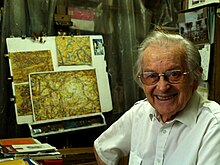Yehuda Bacon

Yehuda Bacon (
Biography
Yehuda Bacon was born into a
In June 1944, Bacon saw his father murdered in the
After his recovery, Bacon returned to
In 1946, Bacon immigrated to Israel with the help of Youth Aliyah. There he studied at Bezalel Academy of Arts and Design. In 1959, he became a professor of graphic art and drawing at Bezalel.[1]
Yehuda Bacon lives with his wife Leah Bacon in Katamon neighborhood of Jerusalem. He has two sons and a daughter by a former marriage to Josephine Bacon.
Art career

After liberation, Bacon decided to become an artist to process his experiences and try to describe what he lived through.
Bacon's drawings show details and sequences of what he saw in the concentration camps and scenes he drew as a teenager shortly after the liberation. His drawings served as evidence in trials against Nazi criminals (including the
His art is a kind of asynergistic interaction: on the one hand, Bacon processes the experiences of his childhood and youth in the concentration camps, on the other he is searching for a way of understanding through his art. Bacon was early part of interfaith dialogues and Israeli-Palestinian dialogue in the 1950s. His art is shown in several museums and collections around the world, among the Israel Museum and Yad Vashem in Jerusalem, the United States Congress in Washington, D.C., in the homes of Theodore Roosevelt, John D. Rockefeller, Martin Buber and Chaim Weizmann as well as in London.
Collections
- Yad Vashem, Jerusalem
- Ghetto Fighters' House Museum, Western Galilee
- Victoria and Albert Museum, London
- British Museum, London
- Imperial War Museum, London
- Magnes Museum, Berkeley
- Museum am Dom, Würzburg
Solo exhibitions
- Nora Gallery, Jerusalem (1954)
- Whippmann Gallery, Johannesburg (1955)
- Princeton University, Princeton (1973)
- Lutheran Education Center, Munich (1978)
- Portland City Hall, Portland, Oregon (1988)
- SOCA Gallery, Auckland (1995)
- Studio Visuri Osmo, Helsinki (1999)
- Spectrum Gallery, Frankfurt (2004)
- Museum am Dom, Würzburg (2008)
- Czech Centre, Prague (2011)
Group exhibitions
- Henny Handler, London (1987) starring Naomi Blake
- St. Paul's Church, Frankfurt (1999) with Dan Richter-Levin
- Art Museum, Tel Aviv (1952) with Isidor Aschheim, Naftali Bezem, Nahum Gutman, Aviva Uri, et al.
- 45e Exposition de la Maison des intellectuels, Paris (1962)
- National Museum of Modern Art, Tokyo (1962)
- Pratt Graphic Art Center, New York (1966)
- Art Gallery, São Paulo, (1967) by Mordechai Ardon, Moshe Castel, Jacob Pins, Anna Ticho, Yigael Tumarkin, et al.
- Gallery of Modern Art Rijeka, Ljublijana (1968)
- Musée d'Art Moderne, Paris (1981)
- Imperial War Museum, London (2001)
- The Brooklyn Museum of Art, New York (2003)
- Los Angeles Museum, California 2004
- Ben Uri Gallery, London (2008) - Israel and Art - 60 years through the eyes of Teddy Kolek
See also
References
External links
- Yehuda Bacon Webpage Archived 2013-06-25 at the Wayback Machine
- Yehuda and Leah Bacon Fellowship (German)[permanent dead link]
- Interview with his daughter, BBC journalist Hanna White
- Interview with Yehuda Bacon, Yad Vashem website
- Yehuda Bacon in the Yad Vashem exhibitions, Jerusalem
- Special Exhibition in Yad Vashem
- Bezalel Academy Jerusalem
- Bacon exhibition in the Museum am Dom Würzburg (German) Archived 2011-07-19 at the Wayback Machine
- Art and Holocaust
- Yehuda Bacon at Memory of Nationsite.
